this is the thread that discusses issues with meshing for import into ABEC
starting with post #10
2way spkr abec model
starting with post #10
2way spkr abec model
not such a strong statement as that but leaning that way. I think the effect is small; smaller than other deficiencies in my model.Ah so you are saying that I wont see any noticeable results from this except baffle width and depth?
.
Its not just me. Notice for example that most KEFs don't have roundovers. of course KEF Blade does but that is cost no object.
Yes I found it already with you recommendation, thanks. Lots of stuff to go through :b
I thought the reason with factory speakers being sharply squared was mostly cost?
KEF drivers leave me cold though, I don't get the attraction at all.
Since we are doing it ourselves then it is no longer a cost issue, but an issue of finding a friend with a CNC machine 😀
Waveguides seem to be the most important part, yes.
I thought the reason with factory speakers being sharply squared was mostly cost?
KEF drivers leave me cold though, I don't get the attraction at all.
Since we are doing it ourselves then it is no longer a cost issue, but an issue of finding a friend with a CNC machine 😀
Waveguides seem to be the most important part, yes.
I broke my collarbone about 6 weeks ago - its almost better now - and so knowing I wasn't going to be wrestling with speakers for a while I did more simulations.
First a segway from OB to cardioid - I explored a D&D 8C clone/relative using the same Radian 5208C coax plus a Purifi PTT8 on the front an SDX10 subwoofer facing rear. There was some magic in mating the 8" midwoofer of the coax to the 8" woofer just below it. I think it was the directivity match from same sizes that made the XO smoother than I could achieve in my OB between the coax mid and the 15OB350. But while ABEC could find the passive cardioid slot configuration that would provide the desired directivity, it could only hint how to implement the acoustic filtering behind those slots. The real attraction of this design is that I could build a Hypex plate amplifier into the stand for it and achieve a much smaller footprint than with OB. OTOH, I know myself well enough to know I don't have the patience to sit for hours fine tuning the absortion, nor could my wife stand to listen to me doing that.
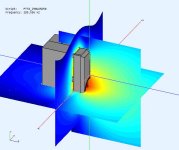
Nevertheless, its an interesting concept that might be worth developing further some day.
But I went back to the OB concept to see if I could improve it.
One thing I needed to do was optimize the vertical position of my hole in the baffle, HinB. The vertical response was still somewhat tilted because I hadn't matched the extent of baffle above the 5208C to the distance to the HinB below it. The image below shows the problem. At the upper end of the range, the tilt varies with frequency and the vertical polar map isn't exactly pristine.
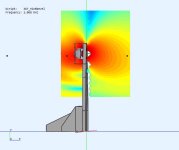
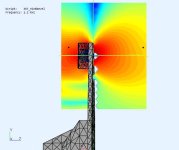
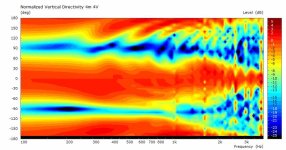
First I made the baffle taller to equalize the distance. This vastly improved the spectral tilt problem but there was something else going.
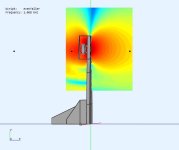
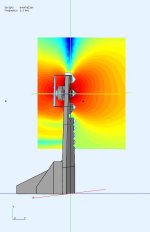
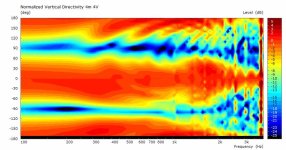
and you can see it in the images above - there is standing waves between the rear sub and the coax driver.
I confirmed this by removing the sloping rear sub from the simulation. This was more like it:
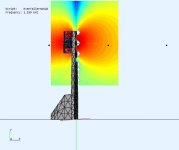
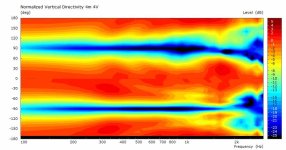
But I need that sub so I reverted to a flat rear sub but turned it upside down so now its downfiring, eventually through a slot in the front baffle. There is room for 2" of absorption on top of the sub. Here are the 5208 simulation results with the damped/padded flat rear sub:
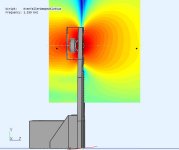
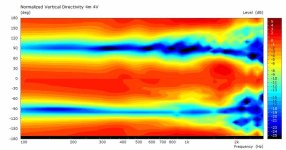
Not quite as good as no sub but nothing I couldn't have fixed by increasing the absorption coefficient. In real life there would be floor reflections as well as sub cabinet reflections to muddy the picture.
Finally, I put the baffle height back to the original value and moved the HinB.
Here is what the concept looks like now, imperfectly rendered in Sketchup. I see I still haven't moved the HinB up a little to match the simulation

First a segway from OB to cardioid - I explored a D&D 8C clone/relative using the same Radian 5208C coax plus a Purifi PTT8 on the front an SDX10 subwoofer facing rear. There was some magic in mating the 8" midwoofer of the coax to the 8" woofer just below it. I think it was the directivity match from same sizes that made the XO smoother than I could achieve in my OB between the coax mid and the 15OB350. But while ABEC could find the passive cardioid slot configuration that would provide the desired directivity, it could only hint how to implement the acoustic filtering behind those slots. The real attraction of this design is that I could build a Hypex plate amplifier into the stand for it and achieve a much smaller footprint than with OB. OTOH, I know myself well enough to know I don't have the patience to sit for hours fine tuning the absortion, nor could my wife stand to listen to me doing that.

Nevertheless, its an interesting concept that might be worth developing further some day.
But I went back to the OB concept to see if I could improve it.
One thing I needed to do was optimize the vertical position of my hole in the baffle, HinB. The vertical response was still somewhat tilted because I hadn't matched the extent of baffle above the 5208C to the distance to the HinB below it. The image below shows the problem. At the upper end of the range, the tilt varies with frequency and the vertical polar map isn't exactly pristine.



First I made the baffle taller to equalize the distance. This vastly improved the spectral tilt problem but there was something else going.



and you can see it in the images above - there is standing waves between the rear sub and the coax driver.
I confirmed this by removing the sloping rear sub from the simulation. This was more like it:


But I need that sub so I reverted to a flat rear sub but turned it upside down so now its downfiring, eventually through a slot in the front baffle. There is room for 2" of absorption on top of the sub. Here are the 5208 simulation results with the damped/padded flat rear sub:


Not quite as good as no sub but nothing I couldn't have fixed by increasing the absorption coefficient. In real life there would be floor reflections as well as sub cabinet reflections to muddy the picture.
Finally, I put the baffle height back to the original value and moved the HinB.
Here is what the concept looks like now, imperfectly rendered in Sketchup. I see I still haven't moved the HinB up a little to match the simulation
Last edited:
The real "fun" part of this was the ABEC simulation of the down firing slot loaded sub. That requires the driver to be positioned on a horizontal baffle but ABEC is incapable of doing that. It simply has no provisions I could find for shifting/positioning in the Z dimension. I struggled with this for 2 days before giving up modeling with a vertical baffle, with x,y positioning flexibility.
My model stands up with the slot firing horizontally out the bottom. In the system, it will lay flat and fire out the end. The directivity coming out the mouth of the slot can be imported directly into Vituix.
This model has two subdomains: the rear chamber in green and the slot in yellow. The rear chamber walls are damped. There is an "interface" between the slot and the exterior domain at the mouth of the slot.

I'm only going to use this sub up to 100 Hz or so but it appears to be good much higher. The model is somewhat pessimistic because I've positioned the driver further away from the mouth opening then it needs to be and I haven't blocked off the back of the slot behind the driver. It was just too much trouble to bother with knowing I didn't needed extended response range. This may give comfort to those considering ripole subs.
The directivity is omni past 100 Hz:
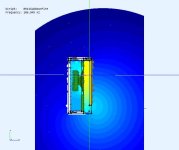
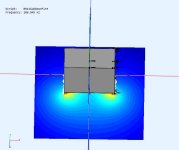
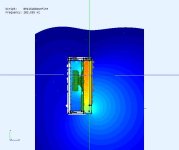
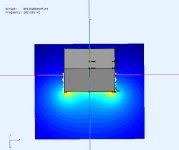
The first graph below is the SPL with a 38mm thick slot. The second is with half that thickness.
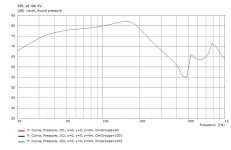
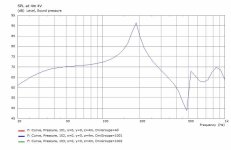
now the polar maps
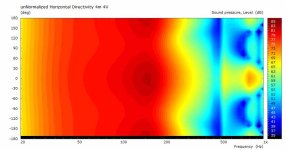
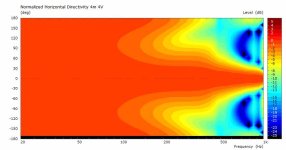

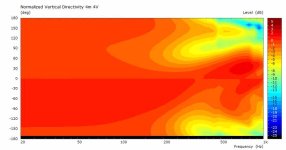
and the curves
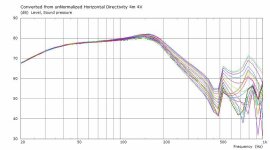
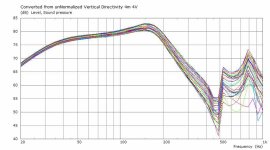
My model stands up with the slot firing horizontally out the bottom. In the system, it will lay flat and fire out the end. The directivity coming out the mouth of the slot can be imported directly into Vituix.
This model has two subdomains: the rear chamber in green and the slot in yellow. The rear chamber walls are damped. There is an "interface" between the slot and the exterior domain at the mouth of the slot.
I'm only going to use this sub up to 100 Hz or so but it appears to be good much higher. The model is somewhat pessimistic because I've positioned the driver further away from the mouth opening then it needs to be and I haven't blocked off the back of the slot behind the driver. It was just too much trouble to bother with knowing I didn't needed extended response range. This may give comfort to those considering ripole subs.
The directivity is omni past 100 Hz:




The first graph below is the SPL with a 38mm thick slot. The second is with half that thickness.


now the polar maps




and the curves


I import all the ABEC directivities into Vituix and get the system response:

The combination of the forward firing slot sub with the OB woofer produces directivity in the region of their crossover:

The design retains the moderated SBIR of the earlier version.

The combination of the forward firing slot sub with the OB woofer produces directivity in the region of their crossover:
The design retains the moderated SBIR of the earlier version.
Vertical 0to90

Horiz 0to90

the coax tweeter drives above 1200 hz and won't be as good as shown as its limited by woofer cone's conical shape. not the ROSSE shape I used to generate the directivity
Horiz 0to90
the coax tweeter drives above 1200 hz and won't be as good as shown as its limited by woofer cone's conical shape. not the ROSSE shape I used to generate the directivity
https://www.costco.com/teakhaus-edge-grain-cutting-board.product.4000213210.html
I saw this pop up in my social media feed. A fifteen pound butcher block, for sale at Costco, for under $70.
It's definitely not as impressive as Perry's baffle, but could be an interesting option for builds like these.
Ikea sells some big cutting boards that look promising, but Ikea tends to do everything they can to keep the weight of their items down, and for a loudspeaker baffle, "heavy" offers many benefits. Just something to consider if you're terrible at woodworking like I am.
I saw this pop up in my social media feed. A fifteen pound butcher block, for sale at Costco, for under $70.
It's definitely not as impressive as Perry's baffle, but could be an interesting option for builds like these.
Ikea sells some big cutting boards that look promising, but Ikea tends to do everything they can to keep the weight of their items down, and for a loudspeaker baffle, "heavy" offers many benefits. Just something to consider if you're terrible at woodworking like I am.
Like this 6 foot x 25 inch x 1.5" thick butcher block slab at Home Depot https://www.homedepot.com/p/HARDWOO...ntertop-With-Eased-Edge-BBCT152574C/301812823
Hey guys, don't want to hijack the thread, or go into off topic too deep.
The OB posts have me thinking about an unusual project...a combination OB and unity/synergy.
One of my favorite builds, showing the back side is the is this guy.....
View attachment 1251151
The four 4" mids are already "open baffle" in that they radiate backwards openly, albeit at a 45 degree angle. (horn is 90 degree H)
I'm thinking about putting two 15" drivers on the horn walls, butting up close to the mids, and being open back just like the mids.
What do you think?
For the most part, I use open back mids on my Unity horn projects.
If you look at some of my old threads, I have built some metamaterial enclosures for tweeters. I really liked how those worked and how they sounded; I'd argue that it was one of my most successful experiments I've ever done. The improvement is real.
BUT...
I also began to notice that open back mids have a similar sonic 'signature.'
This is pure conjecture on my part, but my 'hunch' is that one of the advantages of an open back tweeter or midrange isn't just the radiation pattern, it also contributes to an improvement in the crossover region. This could be because there's no energy inside of the enclosure that's re-radiated through the loudspeaker diaphragm. (Because there's no enclosure.) Or it may be that the enclosure is raising the Q of the system, and the high Q of the system makes the driver sound "resonant." But whatever it is, it sounds better IMHO.
The fact that it's way easier to build is a bonus 🙂
As far as the sound in the room, it doesn't sound a heck of a lot different besides what's mentioned above. IE, it doesn't SOUND like a dipole. I think this is likely because the sound radiated from the front of the diaphragm is significantly louder than the sound radiated to the back, because the sound off the front of the diaphragm is louder than the back. Often by a lot, as much as 10dB.
Right now I have bipoles in my listening room. I made them using a pair of speakers, back to back, with DSP delay to create a cardioid pattern. Something I noticed with the bipole is that once the back speaker is attenuated by as little as 3-6dB, you can barely tell that it's playing at all.
IIRC, the old-school Bose 901s had the FRONT side of the speaker attenuated, not the back. Almost a cardioid in reverse - but it's not a cardioid because there's no delay.
I would never hope to get dipole response from open back mids on a Synergy; too much difference between front and rear patterns as well as amplitude, as Patrick notes. I might try to put some absorption over them and get a cardioid-like response...and I might have to at least partially close the backs to get it to work. I made a couple of quick stabs at this in simulation and never succeeded. I prefer to think that a well done coaxial is as good as one can hear. The improvement theoretically possible with an optimized horn_MEH and side drivers or open back mids would be diminished/diminishing returns.
Speaking of difference between front and back radiation patterns...consider the radiation patterns from the front and back sides of a conical woofer. The front angles in like a horn, the back angles out. Surely a difference in pattern results and is greater the deeper the cone. I noted this before and commented in another thread that one is likely to get the best dipole response from a planar radiator.
I've been looking at the FaitalPro 8HX200 as an alternative to the Radian 5208C_Be, initially for cost - $500 vs $1000 but also because the data sheet FR is smoother. From eyeballing and scaling the data sheets, it appears that the Faital has a shallower cone and my ABEC sims do predict an arguably better response for it. OTOH, the Radian has better motor params for OB and its CD can cross at 1200 Hz vs 1700Hz., so the jury is still out.
My polar map_Hnorm for the 8HX200:

The primary difference between this result and the 5208C results posted earlier is the driver cone depth; there might be small difference in the overall baffle shape as the overall height and width of the baffle have evolved.
I've been looking at the FaitalPro 8HX200 as an alternative to the Radian 5208C_Be, initially for cost - $500 vs $1000 but also because the data sheet FR is smoother. From eyeballing and scaling the data sheets, it appears that the Faital has a shallower cone and my ABEC sims do predict an arguably better response for it. OTOH, the Radian has better motor params for OB and its CD can cross at 1200 Hz vs 1700Hz., so the jury is still out.
My polar map_Hnorm for the 8HX200:
The primary difference between this result and the 5208C results posted earlier is the driver cone depth; there might be small difference in the overall baffle shape as the overall height and width of the baffle have evolved.
But when I looked at 12" coaxials, I got a different answer relative to beveled baffle or not. I think we have already established that smaller coaxes preserve dipole response to a higher frequency than larger ones. One must not go so small as to compromise dynamics. I think 8" is the sweet spot. The radian 8 in particular because it crosses at 1200 hz, even though the 8HX200 looks better higher up.
One of my segways was to consider the BMS12C32, 12" coax on a separate baffle above a sealed 12" subwoofer. The initial stimulus was a recommendation from @airvoid. I went through a progression from no bevel to a faceted baffle, all 36mm thick. The woofer was always front mounted flush, sometimes with a 45 degree bevel on the back.
 The system, if built, would have looked like this:
The system, if built, would have looked like this:

which isn't entirely unattractive. Instead of a hole in baffle, I have a separate baffle for the coax spaced well above the slant back sub cabinet.
And again, there is very little to complain about in the Vituix system simulation.

the one compromise here is that to avoid strain on the coax woofer, crossover to the sub must occur at 125 Hz to support peak SPL of 105db.
Here are notes from my MaxSPL sim for the 12C362
100 Hz XO hits Xmax at 6.8 V for 100 db Max SPL
125 Hz XO gets to 105 db with 11V, maxX is 3.8mm, lower output to 102 db and maxX reduces to 2.8mm, at 96 db SPL, maxX is 2.2 mm
150 Hz XO gets to 105 db SPL at 11V, maxX is 2mm, Xmax is 4.5mm
The dashed trace in the Power&DI screen is the SBIR. The floor reflection null is deep but very narrow and thus likely not audible, but there is a wide depression of 5 db or so around it. This is different from the 4 way design with an 8" coax that moderate the floor null.
Which is better?
One of my segways was to consider the BMS12C32, 12" coax on a separate baffle above a sealed 12" subwoofer. The initial stimulus was a recommendation from @airvoid. I went through a progression from no bevel to a faceted baffle, all 36mm thick. The woofer was always front mounted flush, sometimes with a 45 degree bevel on the back.
which isn't entirely unattractive. Instead of a hole in baffle, I have a separate baffle for the coax spaced well above the slant back sub cabinet.
And again, there is very little to complain about in the Vituix system simulation.
the one compromise here is that to avoid strain on the coax woofer, crossover to the sub must occur at 125 Hz to support peak SPL of 105db.
Here are notes from my MaxSPL sim for the 12C362
100 Hz XO hits Xmax at 6.8 V for 100 db Max SPL
125 Hz XO gets to 105 db with 11V, maxX is 3.8mm, lower output to 102 db and maxX reduces to 2.8mm, at 96 db SPL, maxX is 2.2 mm
150 Hz XO gets to 105 db SPL at 11V, maxX is 2mm, Xmax is 4.5mm
The dashed trace in the Power&DI screen is the SBIR. The floor reflection null is deep but very narrow and thus likely not audible, but there is a wide depression of 5 db or so around it. This is different from the 4 way design with an 8" coax that moderate the floor null.
Which is better?
I would never hope to get dipole response from open back mids on a Synergy; too much difference between front and rear patterns as well as amplitude, as Patrick notes. I might try to put some absorption over them and get a cardioid-like response...and I might have to at least partially close the backs to get it to work. I made a couple of quick stabs at this in simulation and never succeeded. I prefer to think that a well done coaxial is as good as one can hear. The improvement theoretically possible with an optimized horn_MEH and side drivers or open back mids would be diminished/diminishing returns.
You could solve that by making it like this:
no thanks. that is lacking one to me essential element you find in a passive cardioid - simplicity
Last edited:
I like that open-back mids on unity's are easier too !!! 😀For the most part, I use open back mids on my Unity horn projects.
If you look at some of my old threads, I have built some metamaterial enclosures for tweeters. I really liked how those worked and how they sounded; I'd argue that it was one of my most successful experiments I've ever done. The improvement is real.
BUT...
I also began to notice that open back mids have a similar sonic 'signature.'
This is pure conjecture on my part, but my 'hunch' is that one of the advantages of an open back tweeter or midrange isn't just the radiation pattern, it also contributes to an improvement in the crossover region. This could be because there's no energy inside of the enclosure that's re-radiated through the loudspeaker diaphragm. (Because there's no enclosure.) Or it may be that the enclosure is raising the Q of the system, and the high Q of the system makes the driver sound "resonant." But whatever it is, it sounds better IMHO.
The fact that it's way easier to build is a bonus 🙂
My take is they do sound better simply from not having box reflections coming back through them....as you talk about.
Also agree with little if any dipole effect occurs, given the horn strength vs rear wall bounce. I'm guessing any dipole action is down over 20dB, without really knowing how to measure it.
On mine, mids typically cover two-octaves at most.
I don't see Xovers as presenting any issues at all. For me, xovers represent an opportunity to use drivers only in their optimal response range. (where mag and phase are naturally flat)
I'm confident I can put any number of xovers anywhere...with only upsides to consider, no downsides, ....other than increased constant latency for entire speaker.
I would never hope to get dipole response from open back mids on a Synergy; too much difference between front and rear patterns as well as amplitude, as Patrick notes. I might try to put some absorption over them and get a cardioid-like response...and I might have to at least partially close the backs to get it to work. I made a couple of quick stabs at this in simulation and never succeeded. I prefer to think that a well done coaxial is as good as one can hear. The improvement theoretically possible with an optimized horn_MEH and side drivers or open back mids would be diminished/diminishing returns.
Agreed on no dipole response, as just replied to Patrick. My idea to slab some open back 15"s on a syn/unity, in addition to the open mids, is more about ease of construction than hoping for any real dipole action. And I think ff I wanted dipole I'd need some kind of rear facing HF/VHF like I've seen Perry add.
I don't care much about cardioid ....well, not at all really. Must admit the whole idea seems like a complicated acoustic band-aid to me.
But then again, i'm still not into trying to optimize in rooms. maybe someday...before I croak lol 🙂
One of the reasons that the midranges in Unity and Synergy horns are sealed is because it raises the overall output quite a bit.
I'm sure you already know this, but for people who are curious:
All of the drivers in a Unity or Synergy horn are basically in bandpass alignments. The back chambers are made especially small, which creates a peak in the response. The peak in the response raises the overall output, and it can be quite a lot, as much as six decibels or more.
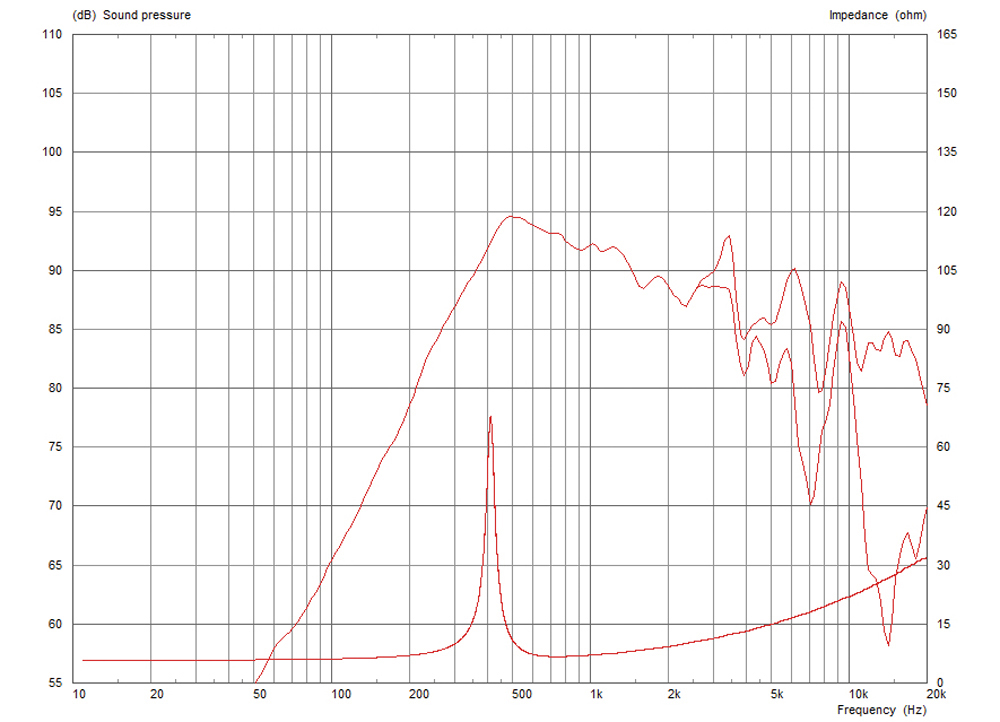
This is the response curve from the mids used in some of the Danley products. You can see that 6db-ish bump there.
Besides increasing output, it also limits low frequency excursion.
Something that I've long wondered, is if you make the back chamber so small that a reflection can't form, is that as good as having it open back?
For instance, the back chamber on that midrange is less than a centimeter away from the cone. It's so close, a reflection can't form. I mean, it COULD, but it would only form at a high frequency. (17khz I think?)
But it's difficult to evaluate whether this is true, because the back chamber ALSO increases the Q of the alignment, and that's definitely audible. You can see it, clear as day, in a CSD plot.
Tapped horns also have a terrible CSD - you can see that in the measurements at data-bass.com. But I think tapped horns sound great. My hunch is that CSD issues are likely more audible as frequencies get higher.
I'm sure you already know this, but for people who are curious:
All of the drivers in a Unity or Synergy horn are basically in bandpass alignments. The back chambers are made especially small, which creates a peak in the response. The peak in the response raises the overall output, and it can be quite a lot, as much as six decibels or more.

This is the response curve from the mids used in some of the Danley products. You can see that 6db-ish bump there.
Besides increasing output, it also limits low frequency excursion.
Something that I've long wondered, is if you make the back chamber so small that a reflection can't form, is that as good as having it open back?
For instance, the back chamber on that midrange is less than a centimeter away from the cone. It's so close, a reflection can't form. I mean, it COULD, but it would only form at a high frequency. (17khz I think?)
But it's difficult to evaluate whether this is true, because the back chamber ALSO increases the Q of the alignment, and that's definitely audible. You can see it, clear as day, in a CSD plot.
Tapped horns also have a terrible CSD - you can see that in the measurements at data-bass.com. But I think tapped horns sound great. My hunch is that CSD issues are likely more audible as frequencies get higher.
Hi, yeah, cardioidish pattern emerges from sheer bulk of speaker box alone, so if one can accommodate big speaker there is no need. Your big synergies control directivity quite low in frequency so there really is no need. But, if one must have small system then there is opportunity to extend controlled directivity bit lower in frequency. Perhaps there is some help for room modes as well, if one extends cardioidish pattern low enough, but it would bring the bulk back as you'd now need multiple big woofers to have any low end.I don't care much about cardioid
Passive cardioid mid has advantages beyond pattern control though. Holes on the box enable impossible thing: it makes inside volume of the box big and outside of small, which are desirable features for number of "box issues". But, it's not free lunch like always, doesn't suit all applications. Makes a three way system, perhaps requires DSP and so on. All good for me, but not for all 🙂
- Home
- Loudspeakers
- Multi-Way
- Dipole and Uframe models and discussion re' Live Edge Dipoles